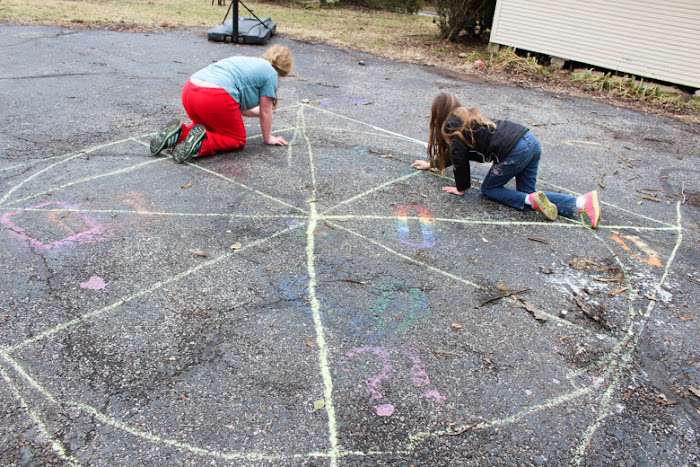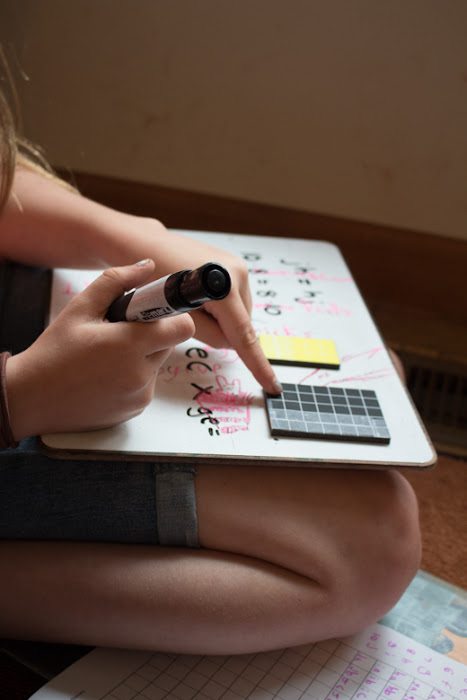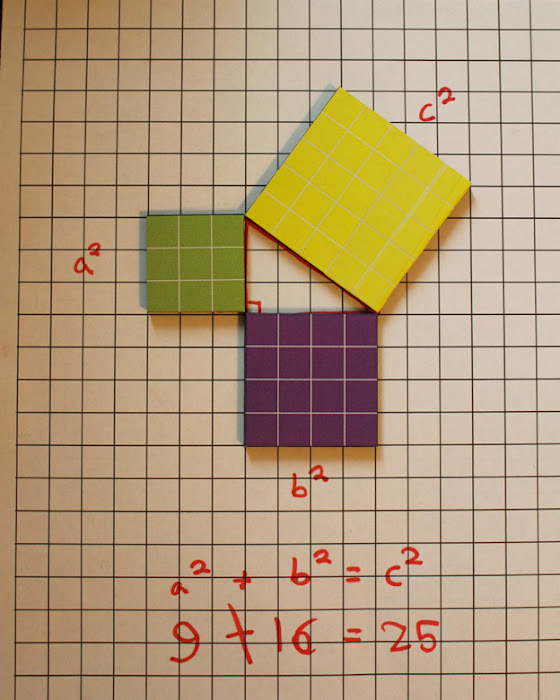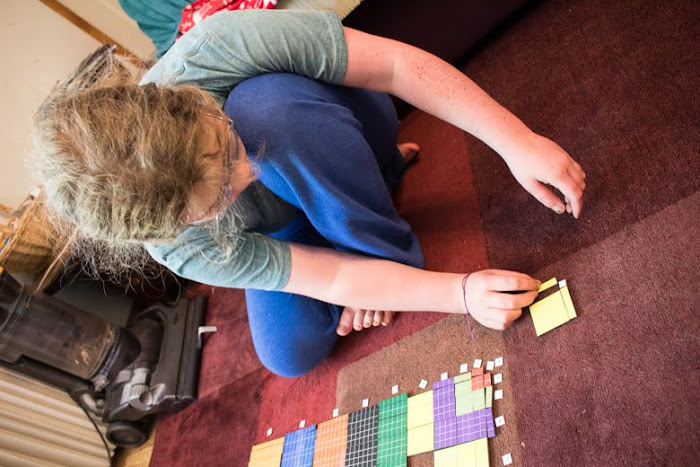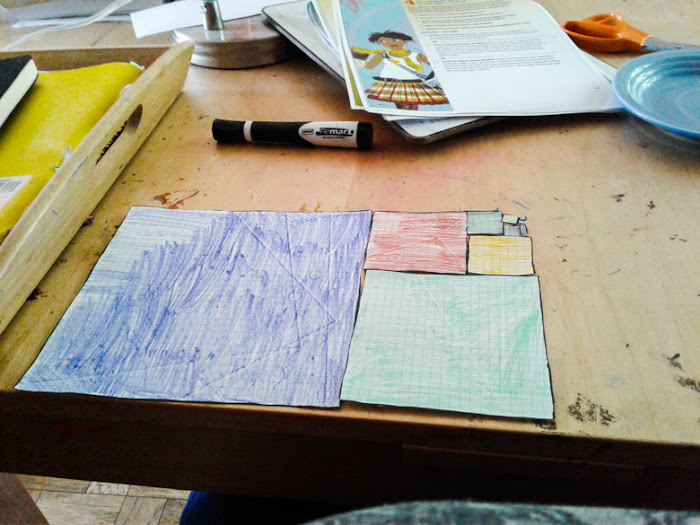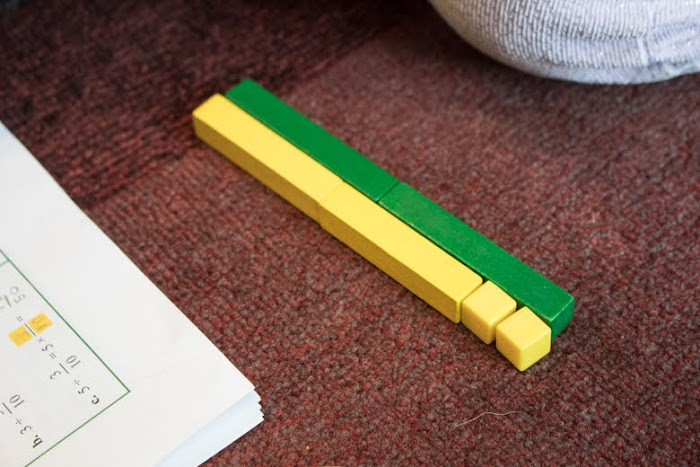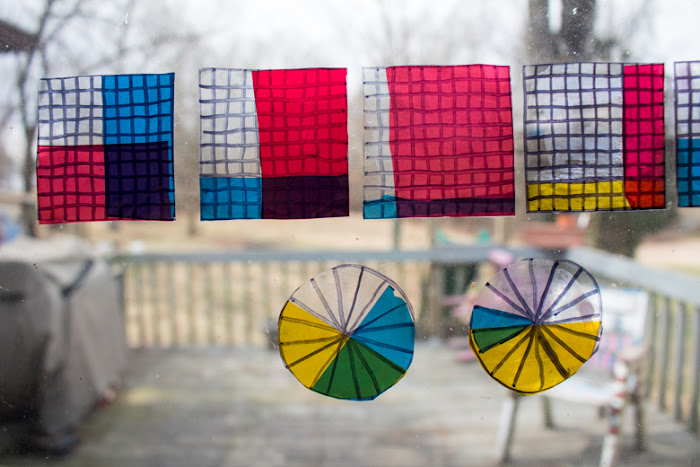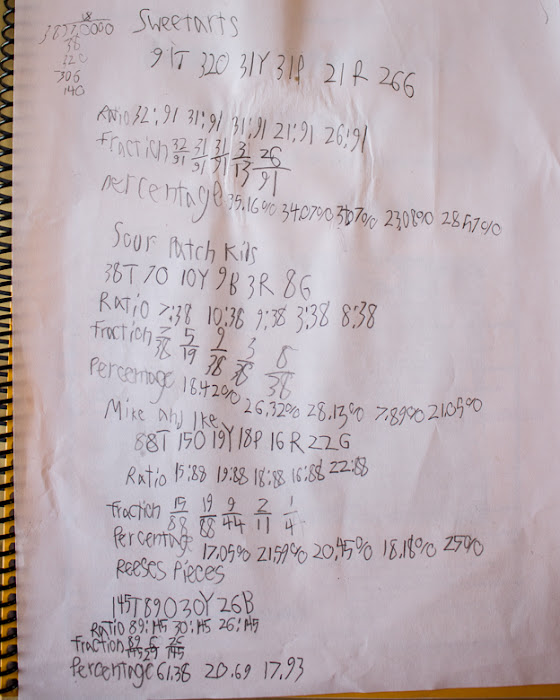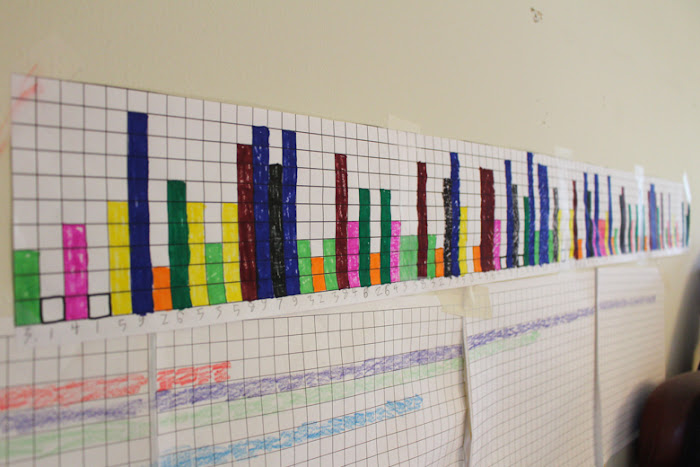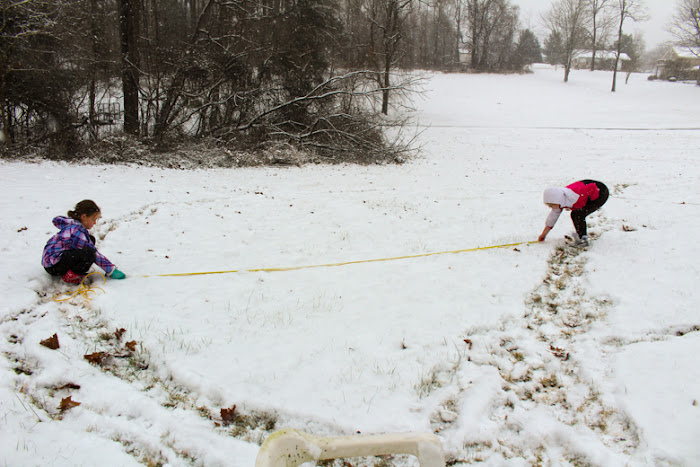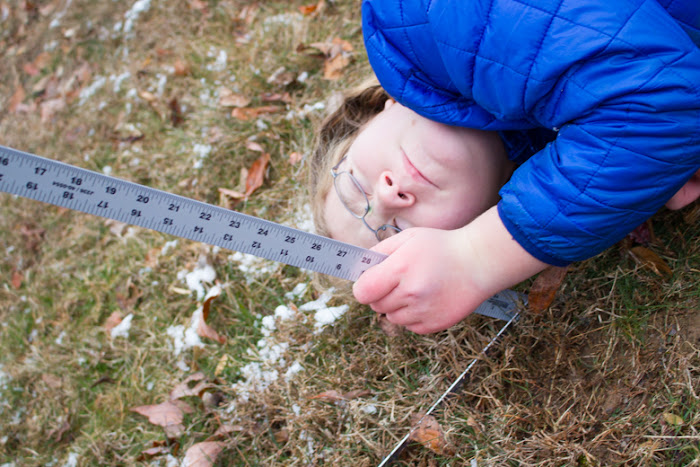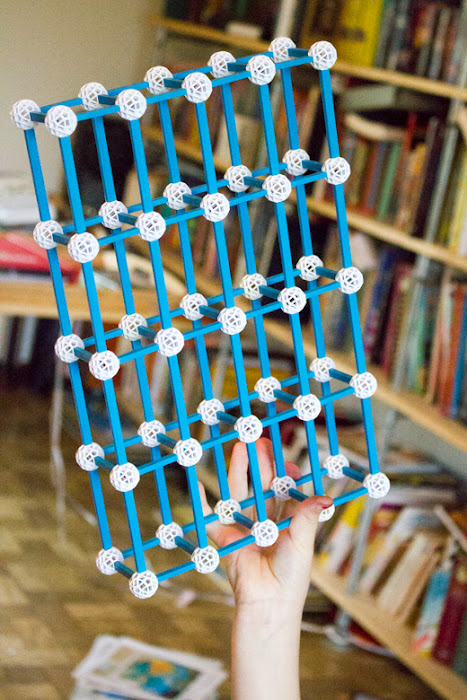In a lot of ways, middle school and high school are GREAT years to homeschool math. Homeschool math curricula are written to the student in these grades, so most of your mentor time is simply keeping them on track and making sure they're completing their work correctly.
This, though, seems to be when a lot of parents lose confidence. Yes, you can teach your kid how to multiply multi-digit numbers with your eyes closed (I hope! If not, just look it up--it's easy to re-learn). But if your kid needs help with quadratics, you might be at a loss, because you don't remember that nonsense AT ALL, and now you're back to thinking that you're terrible at math, you don't like it anyway, and you probably shouldn't be teaching your kid, anyway.
I'm not going to tell you whether or not you should be teaching your kid, but I AM going to tell you that middle school math and high school math are NOT beyond you. The only reason you think they are is that your kid's independence has meant that you've stopped following along with them in their math curriculum, and of course you're going to be lost when they ask you to help with some random skill that you haven't reviewed the background for.
So keep following along in your kid's math, even if they can follow it themselves these days. And even when they don't need your help, keep doing enrichment with them. All those fun games and activities and craft projects and puzzles that inspired them to love math in the elementary years are still fun and inspirational, and being older and knowing more skills just means that they can be exposed to even cooler games and activities and craft projects and puzzles! Sometimes math is going to be a real slog for them, because some of those skills ARE hard and DO take a lot of grit to master, and while that grit is also a very important lesson, kids also need to be reminded that math is fun and exciting.
That's what YOU'RE for!
The kids' curriculum for middle school math was the same as for elementary school math, Math Mammoth's Light Blue Series. After a kid finishes level 7, she's ready for Algebra!
For part of middle school, we also used this text as a combined math/science/history study:

Here are some other textbook, reading, and viewing resources that we used:

This is Will's curriculum for high school math:
- Art of Problem Solving Introduction to Algebra: This was Will's Algebra 1 curriculum, which we spread out for all of eighth and ninth grades. We used the textbook alone for the first half, until I got sick to my bones of Will turning my corrections into a power struggle and switched her to their AOPS online classes. They're spendy as hell, and if we couldn't afford them I'd still be teaching her, myself, but it's quite the relief to no longer be the object of math-related ire!
- Art of Problem Solving Introduction to Geometry: After Algebra 1 comes geometry!
- Art of Problem Solving Intermediate Algebra. Will is going to start this class later in August. After that, I'm confident that AOPS precalculus and calculus will see her through to graduation!
Here are some other textbook, reading, and viewing resources that we used:
Depending on your kid's interest and attention span, middle and high school open you up to the whole range of books and documentaries geared to a general audience. You are going to be shocked at how many really fun non-fiction books on mathematical topics there are! There are histories, biographies of mathematicians, cool things that people have done using math--seriously, do a catalog search at your library! It's going to be awesome! There are also tons of documentary series and high-quality feature films--think about the first time you watched something like Primer or The Astronaut, and how inspired you were. Now imagine that you're a teenager with a billion opportunities in front of you. It's really exciting!
I don't have a list of must-have manipulatives and enrichment resources for these grades, because there aren't really any "must-haves." That doesn't mean that middle and high school kids DON'T need manipulatives, however--just the opposite! Middle and high school kids have the sophistication to use anything in the real world that interests them, or any high-quality tools and supplies that might help them engage in their passions or inspire them to try something new. Here are some of the super random things that my kids have enjoyed and that have given them a deeper understanding of mathematical concepts:
Here are some of the other exciting stuff that we've done in middle and high school math. Just like with elementary math, some of these projects were inspired by what the kids were currently studying or their interests at the moment, and some were cool projects that I presented to them or that we did as a family. I like both ways--if the kids are studying geometry, for instance, that's the perfect time to introduce some really wild and fun geometry activity, but it's also the perfect time to introduce some really wild and fun very much NOT geometry activity, too. Get those brains ranging deep and wide!
- Archimedes' Method of Exhaustion to Calculate Pi. We're kind of collectively obsessed with pi in our homeschool. I'm also a huge history nerd, so I was all about showing the kids how Archimedes approximated pi by calculating the perimeters of of inscribed and circumscribed regular polygons on a circle... and then I had the kids try it!
- Level this down to a challenging elementary activity by simply showing a kid how to draw circumscribed and inscribed regular polygons on a circle.
- This activity also works as-is for high school.
- Map Coloring. Using the greedy algorithm makes map coloring surprisingly systematical (and fun!), but it's still a tricky little challenge.
- Mathematical map coloring can be used as-is as a challenging elementary activity.
- Mathematical map coloring can be incorporated into geography and history studies at the high school level. There are always maps to color!
- Model Algebraic Equations with a Decanomial Square. This is a terrific introductory exploration of how to write and solve algebraic equations.
- Level this down to a challenging elementary activity by using it as an extension after a kid learns how to calculate area.
- Level this up to high school by asking the kid to simplify the equations they create.
- Model the Pythagorean Theorem with the Decanomial Square. The decanomial square is endlessly useful! Here, you can use some of the square pieces and some centimeter graph paper to model and test the Pythagorean theorem.

- DIY Binomial Square/Trinomial Square Manipulative. This manipulative is related to the binomial cube/trinomial cube, below. Your kid might encounter binomial squares in their math curriculum, but even if they don't, I am a BIG fan of introducing it here. It's great practice in modeling formulas that might seem abstract (and therefore scary), and it's fun!
- Level the binomial square/trinomial square manipulative down to a challenging elementary activity by playing with it after the decanomial square.
- Binomial Square from a Decanomial Square. I love to present the same concept several different ways and at lots of different times. This activity uses the decanomial square to build a binomial square, and then explore creating an equation that represents that configuration. I like it even better than the manipulative, above, because there are so many more choices a kid can make.

- Area Models to Square Binomials and Trinomials. Before (or while) you teach the FOIL method to square a binomial, let kids actually see what they're doing! THIS is how FOIL makes sense!
- Level the area models to square binomials and trinomials down to a challenging elementary activity by exploring it without connecting it to the FOIL method.
- Fibonacci Sequence. Middle school is a great time to explore the Fibonacci Sequence for fun! Kids can create their own Fibonacci Sequence models, and then play with pattern creating using them.
- Level Fibonacci Sequence exploration down to elementary by providing the models as manipulatives, and letting kids concentrate on the pattern creating.
- Level Fibonacci Sequence exploration up to high school by including more reading/viewing resources that discuss extensions and applications.
- Fraction Division with Cuisenaire Rods. If all you know about dividing fractions is to invert the divisor and then multiply, you don't *really* understand dividing fractions. Model it with Cuisenaire rods, and you can see what you're actually doing!
- Level this to high school by using it as a review when a kid can't immediately recall the correct algorithm.
- Fraction Multiplication Model Sun Catchers. Here's a really fun project that's as much art as it is math. As long as you choose your sample problems correctly, you'll make a model that will both demonstrate exactly what you're doing when you multiply fractions, AND you'll have a beautiful sun catcher!
- Level this down to a challenging elementary activity by pre-printing the model blanks and encouraging more open exploration of the ways that one can combine two colors rather than specifically making multiplication models.
- Geometry Nets with Building Toys. Convert a kid's building toys into polyhedra models, either challenging kids to come up with specific polyhedra or encouraging open exploration to see what polyhedra are possible. Here are some building toy sets that work well with this activity:
- Level this activity down to elementary by introducing the concept of geometry nets during free play, and encouraging kids to create the nets for some of the Platonic solids.
- Graph Candy. Here's a delicious way to review fractions, decimals, percents, and ratios, as well as how to make graphs and pie charts.
- Graph the digits of pi. Don't believe that pi goes on forever? You will after you've graphed it as far as you can stand! This also makes a beautiful art project, even a permanent installation. It can be a fun activity to do over several days, eventually taking over an entire wall or spreading out across the whole house.
- Level graphing the digits of pi down to elementary by introducing it after learning the concept of graphing. Use Cuisenaire rods as the graph pieces!
- Mark Circles in the Snow. A fresh snowfall is the perfect time to take math outdoors! Here, the kids practice their geometry knowledge by marking a giant circle in the snow. Grab a meter stick or tape measure to take some measurements, and head inside, or snuggle up to a bonfire, to calculate the radius, diameter, and circumference.
- Measure Tall Objects using Ratios of Similar Right Triangles. Get outside and measure something tall!
- This activity works as-is for high school, as well.
- Zometool Crystallizations. The sky's the limit when you figure out how to tile a basic shape in both two and three dimensions. This is a surprisingly tricky logic puzzle, and it's terrific for building patterning intuition.
- You can use this activity as-is in both elementary and high school.
- Tangrams. I first introduced tangrams to the kids when they were very small and we were studying China, but tangrams are such a sophisticated manipulative that you can easily challenge yourself with them no matter how old you are.
- Definitely use tangrams as-in in high school!
- DIY Binomial Cube/Trinomial Cube Manipulative: This is a visual, tangible model of the binomial cube and trinomial cube. Kids can help build it, or simply manipulate it after it's built. You can create pattern cards or work through it verbally. You can use it as a bridge to teach kids the formula or let them figure out a workable formula through their own experimentation.
- Level the binomial cube/trinomial cube manipulative down to a challenging middle school activity by calling it a "puzzle," the object of which is to create a perfect cube.
- Level the binomial cube/trinomial cube manipulative down to an elementary activity by offering it as free play.
I don't blog about every single thing that I do with the kids, so here are some of the Pinboards where I collect even more middle and high school math resources. Some I've done, some I haven't, but I think they all look pretty cool!
- Homeschool Math: Fractions
- Homeschool Math: Geometry
- Homeschool Math: Algebra
- Homeschool: Logic
- Homeschool: Physics
I often tell people that I LOVED homeschooling the early years--I mean, who wouldn't? The picture books! The mud puddles! The field trips to the fire station! But the thing about me that you've probably sussed out is that I need a LOT of mental stimulation--like... a LOT--and homeschooling those little kids didn't always provide it to me. There was a whole summer when I think I fell asleep every single afternoon while reading Syd whatever Rainbow Fairy book she'd presented to me that day. Anyway, homeschooling big kids isn't like that. They can do puzzles and work projects and try activities that genuinely grown-up humans think are cool, too, and don't have all the answers for. That Zometool crystallization activity, for instance? I STILL think about the crystal that I created, and I still kinda think that I accidentally found the cure for cancer or unlocked another dimension with it...
...until, you know, I took it apart so that we could do something else cool with the pieces.
P.S. Want to see what else we do that's cool? I share resources, works in progress, and more updates on our adventures daily over at my Craft Knife Facebook page.


